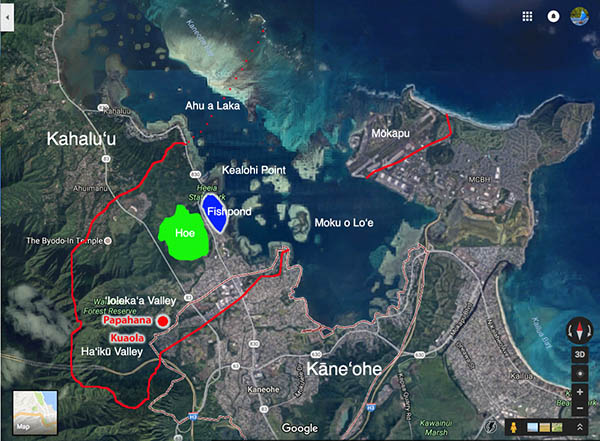 |
 |
 |
|||||
|
Ahupua‘a:
“We do know there’s something special going on in He‘eia,” Kanekoa admits. “And we want to get it moving. The three non-profits in He‘eia are tied together very, very well, and we support each other well and have honest discussions when issues come up. And constantly, I believe, supporting each other. I cannot do it without them. We’re very tight and we all acknowledge our ties together. If they screw up, we get screwed and the fish pond gets screwed. With climate change, if Paepae’s walls aren’t strong enough, and can impact that saltwater wedge, then we get screwed, and vice versa. “We have our work-day every second Saturday. They thought the idea of having the whole ahupua‘a working on the same day was good, but sometimes it competes. They’re so much better-looking than us, so they usually get a fair amount more people.” “Then there’s the Ko‘olaupoko Hawaiian Civic Club and the Ko‘olau Foundation with Mahealani. The civic club, for Kako‘o ‘Ōiwi, has been the backbone for us. There’s Kamakau School that’s up in the Ha‘ikū area. There’s a lot of other organizations, not just the three. “Kako‘o ‘Ōiwi is a non-profit but it’s really a collaboration between three organizations, the Ko‘olaupoko Hawaiian Civic Club, the Nature Conservancy, and the landowner, Hawai‘i Community Development Authority [HCDA]. If you look up HCDA, you’ll see them as the big developer that are building huge high-rises and billion dollar buildings and things. That is true, they are doing all of that. But they’ve also helped us quite a bit and push for the development of this land, as their focus here is agriculture and Hawaiian culture. So, we appreciate their tools and what they can do. “We’re taking three different schools from this area they’re integrating in—He‘eia Elementary, Kāne‘ohe Elementary, and Kamakau School. Support from Hau‘oli Mau Loa Foundation paid for staff to create a better curriculum, and lesson plans to include ‘āina and education. We hopefully are approaching it as Hawaiians, but the reality is the Humanities are already pretty compartmentalized, so it’s just showing that you can do a lesson that covers both math and culture, or math and English, and farming at the same time, right? So it’s like, how can land work together and develop projects and activities? “We hope what we are doing here provides a guidebook. It’s not perfect, but it could be used as a guide, as a model. But obviously, each land is different and each system will kind of tell them how to manage everything. The land will tell the managers how to go. We hope we can figure out some stuff here and learn, and then apply that to other places, whether it’s in Lahaina or other Maui. But I don’t want other people to be told ‘This is how to farm their lands because this is what He‘eia is doing, and therefore you need to change your way.’ That’s the last thing we want.” |
|
|||||
|
|||||

